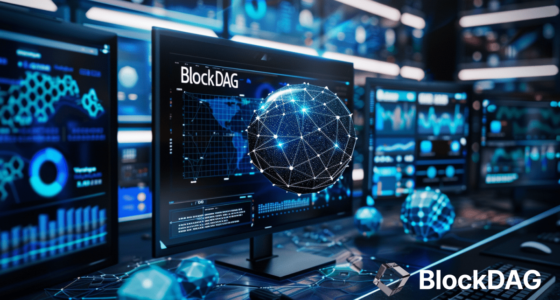As the blockchain and AI landscapes continue to evolve, few projects have generated as much anticipation as UOMI. Set to be one of the most groundbreaking launches of 2024, UOMI is a new Layer 1 (L1) blockchain that promises to revolutionize the way we think about autonomous AI agents. This innovative platform is poised to empower AI entities that are not just intelligent, but also truly autonomous and unstoppable.
What Makes UOMI Different?
UOMI stands out as a disruptive force in the L1 space because it enables the creation of autonomous AI agents with unprecedented capabilities. Imagine AI agents that can independently hold and manage a wallet, execute trades, and make financial decisions without human intervention. But that’s just the beginning.
These AI agents could also be digital artists, autonomously minting NFTs on-chain, creating unique and original content without any human guidance. They could function as Non-Player Characters (NPCs) in games, offering a level of interactivity and intelligence that was previously unimaginable. Or, they could establish and manage Decentralized Autonomous Organizations (DAOs), making governance decisions and driving collective action without any centralized control.
Introducing OPoC: A New Consensus Mechanism
One of the most innovative aspects of UOMI is its consensus algorithm, Optimistic Proof of Consensus (OPoC). Designed specifically to support the complex operations of autonomous AI agents, OPoC is a breakthrough in how decentralized networks handle computation, particularly in AI and machine learning contexts.
OPoC ensures that computations are performed correctly and efficiently without requiring every node in the network to verify each computation. This reduces the computational overhead significantly, making it more efficient than traditional consensus mechanisms like Proof of Work (PoW) or Proof of Stake (PoS).
Why OPoC is Important:
1. Economic Security: UOMI’s AI agents can control and transact valuable digital assets (e.g., tokens, NFTs, voting rights). To protect against malicious actors, OPoC requires validators to stake tokens, which are forfeited if they propagate incorrect computations. This economic incentive/disincentive system ensures that validators act honestly, supporting the network’s integrity.
2. Efficiency: Unlike PoW and PoS, which require substantial computational resources, OPoC only involves a subset of validators in the initial computation. If these validators agree, the result is accepted, reducing the need for network-wide computation. This makes OPoC particularly well-suited for AI model computations that demand high efficiency.
3. Scalability: OPoC enhances the network’s scalability by increasing the parallel computation capability as the number of validators grows. This is a significant advantage over PoW and PoS, where adding more nodes does not proportionally increase computational power.
How OPoC Works:
– Two-Stage Process:
1. Probabilistic Assurance: A small, randomly selected subset of validators performs the computation. If they all agree, the result is accepted.
2. Dispute Resolution: If there’s disagreement among the initial validators, a larger subset is called upon to resolve the conflict. Dishonest validators have their stakes slashed.
– Probabilistic Guarantees: The system is designed to make it economically unviable for attackers. For example, in a scenario where the probability of a successful attack is extremely low, the economic reward required to make such an attack worthwhile would be astronomically high, thus discouraging any rational attacker.
Why UOMI is the One to Watch in 2024
UOMI is not just another blockchain project—it’s being hailed as one of the most promising and awaited innovations of 2024. The potential of autonomous AI agents on a decentralized L1 is immense, and UOMI is at the forefront of this revolution. The project has already attracted significant attention from venture capitalists eager to be part of what could be the next big thing in the AI and blockchain space.
While specific dates are still under wraps, there’s strong speculation that the UOMI token could launch as early as November. The team behind UOMI has reportedly secured agreements with centralized exchanges and launchpads, setting the stage for a highly anticipated debut. However, the official launch details remain closely guarded, adding to the project’s allure and intrigue.
The Future of AI on Blockchain
As AI continues to integrate with blockchain technology, UOMI is positioning itself as a leader in this emerging field. The possibilities of what can be achieved with autonomous AI agents are vast, and UOMI’s platform could unlock new levels of innovation and creativity across multiple industries.
Whether you’re an investor, developer, or simply someone fascinated by the potential of AI, UOMI is a project that you’ll want to keep on your radar. With its innovative approach, cutting-edge consensus mechanism like OPoC, and the excitement building around its upcoming launch, UOMI could very well be the game-changer that defines the AI L1 landscape in the coming years.
UOMI is more than just a new Layer 1 blockchain—it’s a glimpse into the future of AI and decentralization. With the introduction of the OPoC protocol, UOMI is setting new standards for how autonomous AI agents can operate on the blockchain. As we await further details on the token launch, one thing is clear: UOMI is set to be one of the most talked-about and transformative projects of 2024. Stay tuned, because this is one development you won’t want to miss.
Media Details:
name: Crypto Expert PR
email: crypto.expert@gmail.com
This press release was originally published on this site








